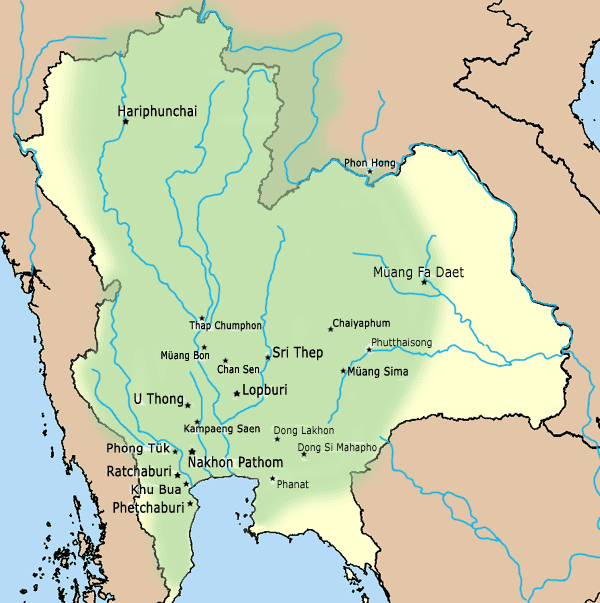Southeast Asia, a culturally rich and diverse region, has been home to some of the oldest and most influential kingdoms in history. These early polities laid the groundwork for later states and civilizations through their political structures, trade networks, religious influences, and artistic achievements. Among the most significant of these early kingdoms were Funan, Chenla, Srivijaya, and Dvaravati.
Funan

Funan is often regarded as the earliest known kingdom in Southeast Asia, flourishing from around the 1st to the 6th century CE. Located in what is now southern Vietnam and Cambodia, Funan was a maritime trading power that controlled key trade routes connecting India and China.
The kingdom is known primarily through Chinese historical accounts and archaeological discoveries. Its strategic location along the Mekong Delta allowed it to become a vital hub in the Indian Ocean trade network, receiving goods and cultural influences from India and beyond.
Funan’s political system was centralized and monarchic, and its rulers were instrumental in introducing Indian culture, especially Hinduism and later Buddhism, into Southeast Asia. Sanskrit inscriptions and Indian-style artifacts have been found in the region, showing the depth of Indian influence.
The kingdom was also one of the first in the region to build irrigation systems and organize agricultural production on a large scale. Funan eventually declined, likely due to internal strife and external invasions, and was succeeded by the Chenla kingdom.
Chenla

Chenla emerged in the 6th century CE as a successor to Funan, occupying much of present-day Cambodia and parts of Laos. Initially, Chenla was a collection of autonomous principalities that gradually unified into a more cohesive state. It is often divided by historians into two phases: Early Chenla and Late Chenla. The former was more decentralized, while the latter marked a shift toward stronger centralized rule.
Unlike Funan, which was more maritime-oriented, Chenla was predominantly inland and focused on expanding its territory through military conquest. The kingdom continued the Indianization process initiated by Funan, evident in the construction of temples and the adoption of Sanskrit for official inscriptions.
Hinduism, particularly the worship of Shiva, was dominant during much of Chenla’s existence. Chenla eventually fragmented into smaller states, setting the stage for the rise of the powerful Khmer Empire in the 9th century.
Srivijaya

Srivijaya, which rose around the 7th century CE and lasted until the 13th century, was a dominant maritime kingdom centered in Sumatra, Indonesia. At its height, Srivijaya controlled large parts of the Malay Peninsula, Borneo, and even parts of Java and the Philippines.
Its power rested on its control of the Strait of Malacca and other key maritime routes, which allowed it to become a wealthy and influential trading empire.
Unlike Funan and Chenla, which were heavily influenced by Indian Hindu culture, Srivijaya was a bastion of Mahayana Buddhism. The kingdom became a major center of Buddhist learning and pilgrimage, attracting scholars and monks from as far as China and India. The famous Chinese Buddhist pilgrim Yijing visited Srivijaya in the 7th century and wrote extensively about its scholarly culture and religious practices.
Srivijaya’s political structure was characterized by a network of allied port cities and a centralized monarchy that maintained control through naval power and strategic alliances.
The kingdom declined gradually due to a combination of internal decay, attacks from rival states such as the Chola dynasty of South India. Plus, the rise of new trading powers like Majapahit which then would become one of the largest empires in Southeast Asia.
Dvaravati

The Dvaravati culture flourished in central Thailand from the 6th to the 11th century CE. Associated with the Mon people, Dvaravati was not a unified kingdom in the traditional sense but rather a network of city-states that shared common cultural and religious traits. Its urban centers were situated along major river systems, facilitating trade and cultural exchange.
Dvaravati played a crucial role in spreading Theravāda Buddhism in mainland Southeast Asia, a tradition that remains dominant in the region today. The kingdom also adopted Indian artistic styles, evident in its sculptures, temple architecture, and coinage.
The political system of Dvaravati was less centralized compared to other kingdoms, but its cities maintained autonomy while sharing a cohesive cultural identity. Though Dvaravati eventually fell under the influence of the Khmer Empire and later Thai kingdoms, its cultural and religious contributions had a lasting impact on the region.



















